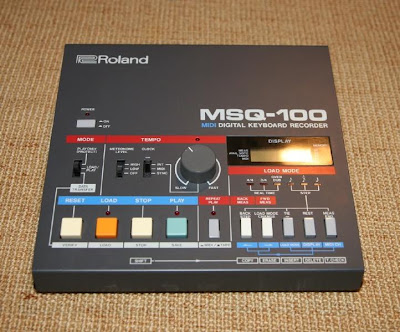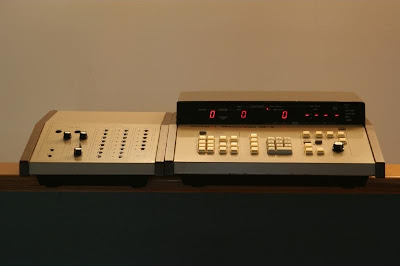
Wednesday, June 06, 2007
Formanta EMS-01

Click here for shots via this auction.
Details:
FORMANTA EMS-01 is an electric music instrument combining a polyphonic organ and a monophonic synthesizer. It is designed to perform music of all genres and to create various sound effects while recording soundtracks for movies and plays, or studio recording. The organ has a 5-octave keyboard, 6 preset sound timbres, frequency vibrato with adjustable vibrato delay, decay adjustment and a stereophaser (common for organ and synthesizer). The "vibrato delay" scheme is activated again only after all the previously pressed keys are released. In the "legato" mode the "vibrato delay" scheme is not activated.
The synthesizer has:
3-octave keyboard;
modulator, modulation voltage from which is applied to frequency modulator, width modulator, filter, and amplifier;
broad band oscillators 1 and 2 (with various waveforms);
mixer, designed for summation of signals from oscillators 1 and 2, noise generator, external source, and ring modulator;
filter, designed for dynamic and static changing of the spectrum of summarized signal from mixer output;
amplifier, designed for making the sound corresponding to various parameters of the envelope;
Visual division of the synthesizer panel into the above listed sections and their lay-out make it more easy to orientate oneself while setting the required timbre. Besides, the synthesizer is able to simultaneously control one more similar synthesizer through a special cable and connectors CONTR IN and CONTR OUT.
The instrument provides the opportunity of connecting stereo headphones; the volume in headphones doesn't change in case of changing the volume of the instrument from zero to maximum at all the outputs of the instrument with the foot pedal; thanks to this, preliminary control of timbre through the headphones before applying it to amplifiers is possible. By switching on PHASER into the channel of organ or synthesizer, it is possible to get stereo sound in the outputs STEREO L and STEREO P. In case PHASER is switched off, both channels will function in MONO mode.
Specifications:
Supply voltage AC 220+10V, 50 Hz;
Power consumption within 75 VA;
Operating conditions: temperature 15-35 C, humidity 65%, barometric pressure 86,6 - 106,6 kPa;
Relative frequency deviation after 4 hours of uninterrupted operation within 0,5%;
5-octave organ keyboard;
Organ band from 43,65 Hz (F controctave) to 1318 Hz (E in three-line octave);
3-octave synthesizer keyboard;
Sound range - 9 octaves;
Adjustment range for organ and synthesizer + 6% (+ 0,5 tone);
Minimal range of continuous detuning of oscillator 2 regarding oscillator 1 - 1 octave;
Range of adjustment of filter cutoff frequency 100- 1500 Hz;
Minimal dynamic range - 55 dB;
Weight within 30 kg.
Sound1
Sound2
Sound3"
Samples mirrored here.
My 263 prototypes
 flickr by verbos2002.
flickr by verbos2002."This is my new creation. The 263 quantizer / shift register. It is a dual 4 stage analog shift register and an 8 channel chromatic quantizer for Buchla systems. The switch in the middle chains to 2 shift registers together for one 8 stage one. These will be available for sale soon, when I get all the bugs out."
Top 10 Synths added to Sticky Posts
Just a heads up. I added the Top 10 Synths Of All Time post to the right, Sticky Posts section.
Doepfer MSY2 MIDI Sync
 via this auction.
via this auction.Details:
"MSY2 is an interface that converts the MIDI realtime events Clock, Start and Stop into the corresponding signals Clock and Start/Stop of the SYNC standard. This standard was used e.g. in the Roland devices TB303 bass line or TR808 rhythm composer.
MSY2 is equipped with 2 SYNC DIN sockets (switched in parallel), a Clock miniature jack socket (3.5mm), MIDI-in and MIDI-Thru. SYNC-CLOCK is a periodic signal (0/+5V) representing the tempo. SYNC-START/STOP is a signal that indicates one of the 2 possible states: START = +5V, STOP = 0V. The Clock pin of the SYNC standard is additionally available from a miniature jack socket e.g. for synchronizing the arpeggio input of an analog synthesizer with MIDI.
 MSY2 enables the 1:1 conversion of MIDI CLOCK to SYNC CLOCK (i.e. 1 MIDI clock triggers 1 SYNC clock pulse), as well as the reduction of the tempo by dividing the incoming MIDI clock frequency by an integer factor. The factor can be set to any value between 1 and 16 with a DIP switch at the bottom of the MSY2. A factor 1 corresponds to the 1:1 conversion, 16 is the maximum of frequency reduction, i.e. after 16 MIDI clocks 1 SYNC clock appears.
MSY2 enables the 1:1 conversion of MIDI CLOCK to SYNC CLOCK (i.e. 1 MIDI clock triggers 1 SYNC clock pulse), as well as the reduction of the tempo by dividing the incoming MIDI clock frequency by an integer factor. The factor can be set to any value between 1 and 16 with a DIP switch at the bottom of the MSY2. A factor 1 corresponds to the 1:1 conversion, 16 is the maximum of frequency reduction, i.e. after 16 MIDI clocks 1 SYNC clock appears.With two other switches the Start/Stop polarity and the Clock polarity can be changed for special applications not following the SYNC standard.
Clock and Start/Stop are displayed with 2 LEDs.
MIDI-In, MIDI-Thru"
Roland MSQ-100
 via this auction.
via this auction.Details:
"Many current MSQ-100 users use it as a MIDI-to-sync converter for the popular Roland TB-303, TR-909 and TR-808. I used mine to sync two Frostwave Fat Controller analog sequencers as seen in the embedded video. Then, if I wanted to sync to my DAW, I flipped a single switch on the MSQ-100 and now they're locked to external MIDI clock. "

Roland MC-8

Update via Chris Carter in the comments:
"I owned an MC8 from 1982 to 2002 and used it on many recording (I bought it from Landscape, who recorded 'Einstein agogo' with it). An article I wrote about the MC8 can be found here."
Click here for shots via this auction.
Details:
"This is the Roland MC-8 MicroComposer. They called it a MicroComposer due to its diminutive foot print. Actually, that isn't true. It was designated as the MicroComposer as it was the first microprocessor controlled sequencer - the Intel 8080, to be precise. In addition to launching the 'MC' moniker, it also introduced other innovative features like copy and paste.
So, if you were an electronic musician in 1977, you could drop $8000 and string together 1000 or so notes with Japanese precision.
 The MC8 provides eight channels of CV and gate outputs for controlling inputs found on synthesizers from Moog, Roland, Arp and others. I used this with a Doepfer A-100 modular, Prophet 5, minimoog and SH-101. There is no MIDI, this is all about a microprocessor coupled as directly as possible to analog voltage outputs.
The MC8 provides eight channels of CV and gate outputs for controlling inputs found on synthesizers from Moog, Roland, Arp and others. I used this with a Doepfer A-100 modular, Prophet 5, minimoog and SH-101. There is no MIDI, this is all about a microprocessor coupled as directly as possible to analog voltage outputs.If you're sequencing drums, you don't have to waste the normal CV outputs (and consume memory with unnecessary note data) by using the additional MPX outputs. You can even automate tempo and the presence of portamento. Or, you could use the MPX outputs in conjunction with a sequential switch to control which of several envelopes are used for a particular phrase. They were clearly thinking of serious, complete automation here.
Controlling it all is an impressive console that looks as if it were responsible for launching ICBMs. It certainly feels that way as all the controls and switches seem designed to withstand a nuclear blast. It worked, too. 30 years later, this machine still works great. If you're at all familiar with a 10-key keypad, you can enter data in by touch, without even looking at the unit. The response of the keypad is delightfully retro and a joy to use. All the buttons have satisfying physical feedback that seems absent on current gear.
The MC-8 was expensive for Roland to build, though. It is reported only 200 left the factory. This is a rare chance to own a unique piece of Roland history. I'm selling this and other items because my work area needs to occupy a smaller space.
Famous users of the MC-8 are reported to include: Kraftwerk, Human League (Dare), Tangerine Dream, Hans Zimmer, Toto, and Tomita.
Included in the auction is the original factory manual, interface cable, CV interface unit and, of course, the MC-8 itself."

PREVIOUS PAGE
NEXT PAGE
HOME













© Matrixsynth - All posts are presented here for informative, historical and educative purposes as applicable within fair use.
MATRIXSYNTH is supported by affiliate links that use cookies to track clickthroughs and sales. See the privacy policy for details.
MATRIXSYNTH - EVERYTHING SYNTH













© Matrixsynth - All posts are presented here for informative, historical and educative purposes as applicable within fair use.
MATRIXSYNTH is supported by affiliate links that use cookies to track clickthroughs and sales. See the privacy policy for details.
MATRIXSYNTH - EVERYTHING SYNTH






























